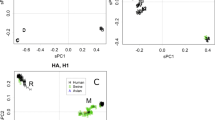Abstract
There are two different mechanisms by which influenza viruses might evolve: (1) Because the RNA genome of influenza viruses is segmented, new strains can suddenly be produced by reassortment, as happens, for example, during antigenic shift, creating new pandemic strains. (2) New viruses evolve relatively slowly by stepwise mutation and selection, for example, during antigenic or genetic drift. Influenza A viruses were found in various vertebrate species, where they form reservoirs that do not easily mix. While human influenza A viruses do not spread in birds and vice versa, the species barrier to pigs is relatively low, so that pigs might function as “mixing vessels” for the creation of new pandemic reassortants in Southeast Asia, where the probability is greatest for double infection of pigs by human and avian influenza viruses. Phylogenetic studies revealed that about 100 years ago, an avian influenza A virus had crossed the species barrier, presumably first to pigs, and from there to humans, forming the new stable human and classical swine lineages. In 1979, again, an avian virus showed up in the North European swine population, forming another stable swine lineage. The North European swine isolates from 1979 until about 1985 were genetically extremely unstable. A hypothesis is put forward stating that a mutator mutation is necessary to enable influenza virus to cross the species barrier by providing the new host with sufficient variants from which it can select the best fitting ones. As long as the mutator mutation is still present, such a virus should be able to cross the species barrier a second time, as happened about 100 years ago. Although the most recent swine isolates from northern Germany are again genetically stable, we nevertheless should be on the lookout to see if a North European swine virus shows up in the human population in the near future.
Similar content being viewed by others
References
Parvin J.D., Mascona A., Pan W.T., Leider J.M., and Palese P., J Virol59 377–383, 1986.
Hinshaw V.S. and Webster R.G. in Beare A.S. (ed).Basic and Applied Influenza Research. CRC Press, Boca Raton, FL, 1982, pp. 79–104.
Hinshaw V.S., Webster R.G., and Rodriguez R.J., Arch Virol67 191–201, 1981.
Kilbourne E.D.,Influenza. Plenum Medical, New York, 1987.
Scholtissek C., Rohde W., von Hoyningen V., and Rott R, Virology87 13–20, 1978.
Fang R., Min Jou W., Huylebroeck D., Devos R., and Fiers W., Cell25 315–325, 1981.
Kawaoka Y., Krauss S., and Webster R.G., J Virol63 4603–4608, 1989.
Scholtissek C., Med Principles Pract2 65–71, 1990.
Shortridge F.K. and Stuart-Harris C., Lancet —, 812–813, 1982.
Scholtissek C. and Naylor E., Nature331 215, 1988.
Scholtissek C., Rott R., Orlich M., Harms E., and Rohde W., Virology81 74–80, 1977.
Scholtissek C., Koennecke I., and Rott R., Virology91 79–85, 1978.
Scholtissek C., Vallbracht A., Flehmig B., and Rott R., Virology95 492–500, 1989.
Bonin J. and Scholtissek C., Arch Virol75 255–268, 1983.
Bean W.J., Hinshaw V.S., and Webster R.G.. in Bishop D.H.L. and Compans R.W. (eds).The Replication of Negative Strand Viruses. Elsevier-North Holland, New York, 1981, pp. 363–367.
Yamnikova S.S., Mandler J., Bekh-Ochir Z.H., Dachtzeren P., Ludwig S., Lvov D.K., and Scholtissek C., Virology197 558–563, 1993.
Kawaoka Y., Naeve C.W., and Webster R.G., Virology139 303–316, 1984.
Klenk H.-D. and Rott R., Adv Virus Res34 247–281, 1988.
Scholtissek C., Bürger H., Kistner O., and Shortridge K.F., Virology147 287–294, 1985.
Webster R.G., Yakhno M., Hinshaw V.S., Bean W.J., and Murti G., Virology84 268–278, 1978.
Scholtissek C., Vaccine3 215–218, 1985.
Gammelin M., Altmüller A., Reinhardt U., Mandler J., Harley V.R., Hudson P.J., Fitch W.M., and Scholtissek C., Mol Biol Evol7 194–200, 1990.
Gorman O.T., Bean W.J., Kawaoka Y., and Webster R.G., J Virol64 1487–1497, 1990.
Webster R.G., Bean W.J., Gorman O.T., Chambers T.M., and Kawaoka Y., Microbiol Rev56 152–179, 1992.
Scholtissek C., Ludwig S., and Fitch W.M., Arch Virol131 237–250, 1993.
Okazaki K., Kawaoka Y., and Webster R.G., Virology131 601–608, 1989.
Gorman O.T., Donis R.O., Kawaoka Y., and Webster R.G., J Virol64 4893–4902, 1990.
Schultz U., Fitch W.M., Ludwig S., Mandler J., and Scholtissek C., Virology183 61–73, 1991.
Ludwig S., Schultz U., Mandler J., Fitch W.M., and Scholtissek C., Virology183 566–577. 1991.
Scholtissek C., Bürger H., Bachmann P.R., and Hannoun C., Virology129 521–523, 1983.
Hinshaw V.S., Alexander D.J., Ayward M., Bachmann P.N., Easterday B.C., Hannoun C., Kida W., Lipkind M., Mackenzie J.S., Nerowe K., Schild G.C., Scholtissek C., Senne D.A., Shortridge K.F., Skehel J.J., and Webster R.G., Bull World Health Organ62 871–878, 1984.
Ludwig S., Haustein A., Kaleta E.F., and Scholtissek C., Virology202 281–286, 1994.
Ludwig S., Stitz L., Planz O., Van H., Fitch W.M., and Scholtissek C., Virology212 555–561, 1995.
Suárez P., Valcácell J., and Ortin J., J Virol66 2491–2494, 1992.
Claas E.C.J., Kawaoka Y., De Jong J.C., Masurel N., and Webster R.G., Virology204 453–457, 1994.
Scholtissek C., von Hoyningen V., and Rott R., Virology89 613–617, 1978.
Nakajima K., Desselberger U., and Palese P., Nature274 334–339, 1978.
Gorman O.T., Bean W.J., Kawaoka Y., Donatelli I., Guo Y., and Webster R.G., J Virol65 3704–3714, 1991.
Fitch W.M., Syst Zool20 406–416, 1971.
Fitch W.M. and Farris J.S., J Mol Evol3 263–278, 1974.
Author information
Authors and Affiliations
Rights and permissions
About this article
Cite this article
Scholtissek, C. Molecular evolution of influenza viruses. Virus Genes 11, 209–215 (1995). https://doi.org/10.1007/BF01728660
Issue Date:
DOI: https://doi.org/10.1007/BF01728660




